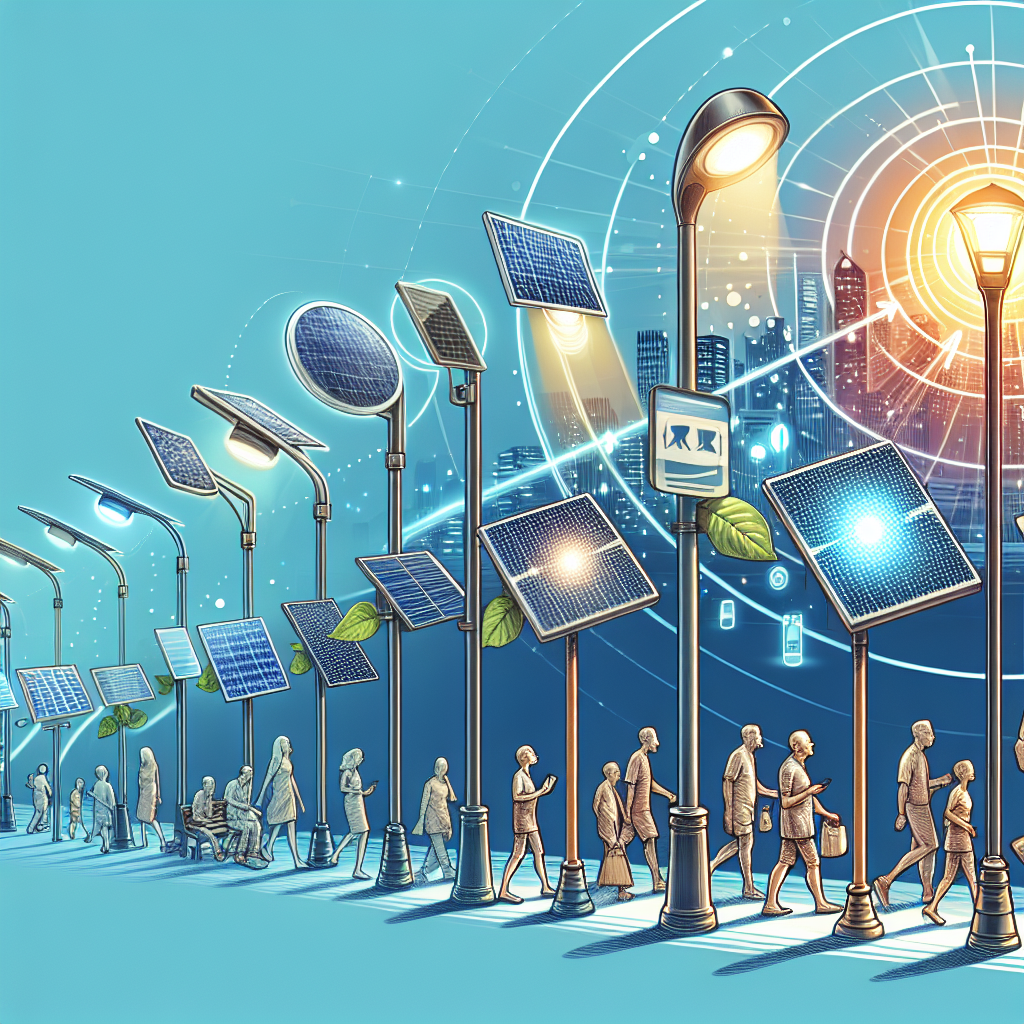Emerging Trends in Commercial Solar Street Lighting
Table of Contents
Emerging trends in commercial solar street lighting are reshaping urban landscapes and enhancing sustainable infrastructure. As cities worldwide strive to reduce carbon footprints and embrace renewable energy, solar street lighting has gained prominence due to its eco-friendly and cost-effective nature. Recent advancements in photovoltaic technology, energy storage solutions, and smart lighting systems are driving this transformation. High-efficiency solar panels, coupled with innovative battery technologies, ensure reliable performance even in low-sunlight conditions. Additionally, the integration of smart sensors and IoT connectivity allows for adaptive lighting, optimizing energy usage and maintenance. These trends not only contribute to energy savings and reduced operational costs but also enhance public safety and urban aesthetics, making solar street lighting a pivotal component of modern urban planning.
Integration Of Smart Technology In Solar Street Lighting
The integration of smart technology in solar street lighting represents a significant advancement in urban infrastructure, offering a blend of sustainability, efficiency, and innovation. As cities worldwide strive to become smarter and more environmentally conscious, the adoption of solar street lighting systems equipped with intelligent features is gaining momentum. This trend is driven by the need to reduce energy consumption, lower carbon footprints, and enhance public safety, all while minimizing operational costs.
One of the most notable aspects of this integration is the use of advanced sensors and connectivity solutions. These smart solar street lights are equipped with motion sensors, which allow them to adjust their brightness based on the presence of pedestrians or vehicles. This not only conserves energy but also extends the lifespan of the lighting components. Furthermore, the incorporation of IoT (Internet of Things) technology enables these lights to communicate with each other and with centralized control systems. This connectivity facilitates real-time monitoring and management, allowing for immediate detection of faults or failures, thereby reducing maintenance time and costs.
In addition to motion sensors, smart solar street lighting systems often include environmental sensors that monitor air quality, temperature, and humidity. This data can be invaluable for city planners and environmental agencies, providing insights into urban climate conditions and helping to inform policy decisions. Moreover, the integration of cameras and audio sensors can enhance public safety by enabling surveillance and emergency response capabilities. These features can be particularly beneficial in high-traffic areas or regions with elevated security concerns.
Another emerging trend in this domain is the use of adaptive lighting technology. This involves the dynamic adjustment of light intensity based on ambient light conditions, traffic density, and specific time schedules. By optimizing light output, cities can achieve significant energy savings while ensuring adequate illumination for safety and visibility. This adaptability is further enhanced by machine learning algorithms, which analyze historical data to predict lighting needs and optimize performance.
The integration of renewable energy sources, such as solar panels, with smart technology is a crucial component of these systems. Solar street lights harness solar energy during the day, storing it in batteries for use at night. The addition of smart technology ensures that this energy is used efficiently, reducing reliance on traditional power grids and contributing to a city’s sustainability goals. Moreover, advancements in battery technology have led to longer-lasting and more efficient energy storage solutions, further enhancing the viability of solar street lighting.
As cities continue to grow and evolve, the demand for smart infrastructure solutions will only increase. The integration of smart technology in solar street lighting is a testament to the potential of combining renewable energy with digital innovation. This approach not only addresses the immediate needs of urban environments but also aligns with broader global objectives of reducing carbon emissions and promoting sustainable development.
In conclusion, the integration of smart technology in solar street lighting is an emerging trend that offers numerous benefits, from energy efficiency and cost savings to enhanced public safety and environmental monitoring. As technology continues to advance, it is likely that these systems will become even more sophisticated, playing a pivotal role in the development of smart cities worldwide. By embracing these innovations, cities can create more sustainable, resilient, and livable urban environments for future generations.
Advancements In Energy Storage Solutions For Solar Lighting

In recent years, the field of commercial solar street lighting has witnessed significant advancements, particularly in the realm of energy storage solutions. As the demand for sustainable and energy-efficient lighting systems continues to grow, the integration of innovative storage technologies has become a focal point for industry leaders. These advancements not only enhance the reliability and efficiency of solar street lighting but also contribute to broader environmental and economic benefits.
One of the most notable trends in energy storage for solar street lighting is the development of high-capacity lithium-ion batteries. These batteries have gained popularity due to their superior energy density, longer lifespan, and reduced maintenance requirements compared to traditional lead-acid batteries. The ability of lithium-ion batteries to store more energy in a compact form factor makes them ideal for solar street lighting applications, where space and weight are often constrained. Furthermore, their longer cycle life translates to fewer replacements over time, thereby reducing the overall cost of ownership.
In addition to lithium-ion technology, there is a growing interest in solid-state batteries, which promise even greater energy density and safety. Solid-state batteries replace the liquid electrolyte found in conventional batteries with a solid material, reducing the risk of leakage and thermal runaway. This innovation not only enhances the safety profile of solar street lighting systems but also allows for more flexible design options. As research and development in this area continue to progress, solid-state batteries are poised to become a game-changer in the energy storage landscape.
Another significant advancement is the integration of smart energy management systems within solar street lighting. These systems utilize advanced algorithms and sensors to optimize the charging and discharging cycles of the batteries, ensuring that energy is used efficiently and effectively. By monitoring environmental conditions and adjusting the lighting output accordingly, smart energy management systems can extend the operational life of the batteries and improve the overall performance of the lighting system. This intelligent approach to energy management not only enhances the sustainability of solar street lighting but also aligns with the growing trend towards smart city solutions.
Moreover, the advent of hybrid energy storage systems is revolutionizing the way solar street lighting is implemented. By combining different types of energy storage technologies, such as lithium-ion and supercapacitors, hybrid systems can leverage the strengths of each technology to deliver superior performance. Supercapacitors, for instance, are known for their rapid charge and discharge capabilities, making them ideal for handling peak power demands. When used in conjunction with lithium-ion batteries, they can provide a balanced solution that maximizes both energy storage capacity and power delivery.
As these advancements in energy storage solutions continue to evolve, they are expected to drive further adoption of solar street lighting in commercial applications. The ability to provide reliable, cost-effective, and environmentally friendly lighting solutions is increasingly attractive to municipalities and businesses alike. Furthermore, the reduction in greenhouse gas emissions and reliance on fossil fuels aligns with global efforts to combat climate change and promote sustainable development.
In conclusion, the emerging trends in energy storage solutions for commercial solar street lighting are paving the way for a more sustainable and efficient future. With continued innovation and investment in this field, solar street lighting is set to play a pivotal role in the transition towards cleaner and smarter urban environments. As these technologies mature, they will undoubtedly contribute to a brighter and more sustainable world.
Sustainable Materials And Design Innovations In Solar Street Lights
In recent years, the field of commercial solar street lighting has witnessed significant advancements, driven by the growing demand for sustainable and energy-efficient solutions. As urban areas expand and the need for reliable public lighting increases, the integration of sustainable materials and innovative design has become paramount. This shift not only addresses environmental concerns but also enhances the functionality and aesthetic appeal of solar street lights.
One of the most notable trends in this sector is the use of sustainable materials in the construction of solar street lights. Manufacturers are increasingly opting for materials that have a lower environmental impact, such as recycled aluminum and biodegradable plastics. These materials not only reduce the carbon footprint associated with production but also contribute to the overall durability and longevity of the lighting systems. Recycled aluminum, for instance, offers excellent resistance to corrosion and weathering, making it an ideal choice for outdoor applications. Similarly, biodegradable plastics are being explored for their potential to minimize waste and facilitate easier disposal at the end of the product’s life cycle.
In addition to sustainable materials, design innovations are playing a crucial role in the evolution of solar street lighting. Modern designs are focusing on maximizing energy efficiency while maintaining aesthetic appeal. One such innovation is the integration of smart technology, which allows for adaptive lighting systems that adjust brightness based on the time of day or the presence of pedestrians. This not only conserves energy but also enhances safety and visibility in urban environments. Furthermore, the incorporation of motion sensors and dimming capabilities ensures that energy is used judiciously, reducing operational costs and extending the lifespan of the lighting components.
Another design trend gaining traction is the modular approach to solar street lighting. Modular designs offer flexibility and scalability, allowing for easy upgrades and maintenance. This approach is particularly beneficial in rapidly growing urban areas where infrastructure needs are constantly evolving. By enabling components to be replaced or upgraded individually, modular systems reduce waste and promote a circular economy. Additionally, they provide municipalities with the ability to tailor lighting solutions to specific needs, whether it be increased illumination in high-traffic areas or more subdued lighting in residential neighborhoods.
The aesthetic aspect of solar street lighting is also receiving increased attention. Designers are exploring ways to blend functionality with visual appeal, creating lighting solutions that complement urban landscapes. Sleek, minimalist designs are becoming more prevalent, with an emphasis on integrating lighting fixtures seamlessly into the environment. This not only enhances the visual appeal of public spaces but also encourages community acceptance and support for sustainable initiatives.
As these trends continue to evolve, the future of commercial solar street lighting looks promising. The combination of sustainable materials and innovative design is paving the way for more efficient, cost-effective, and environmentally friendly lighting solutions. By prioritizing sustainability and embracing technological advancements, cities can reduce their carbon footprint while providing safe and attractive public spaces for their residents. In conclusion, the ongoing developments in sustainable materials and design innovations are not only transforming the landscape of solar street lighting but also contributing to a more sustainable and resilient urban future.
Read more about Solar Street Lighting:
- Emerging Trends in Commercial Solar Street Lighting
- The Environmental Footprint of Commercial Solar Street Lighting
- Commercial Solar Street Lights: Key Market Developments
- Durability and Lifespan of Commercial Solar Street Lights
- Aesthetic Advantages of Commercial Solar Street Lighting
- Troubleshooting Common Problems with Commercial Solar Street Lights
- Sustainable Disposal and Recycling of Solar Street Light Components
- Analysing the Life Cycle Costs of Commercial Solar Street Lights
- Tax Incentives for Installing Commercial Solar Street Lights
- How Commercial Solar Street Lighting Can Boost Property Values
- Improving Public Spaces with Commercial Solar Street Lighting
- Maximizing Energy Collection with Commercial Solar Street Lights








